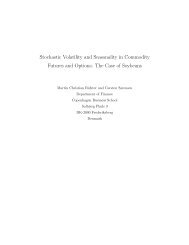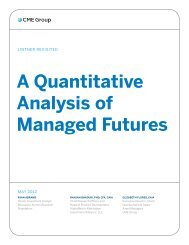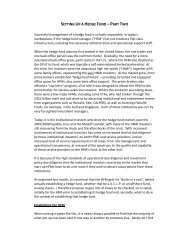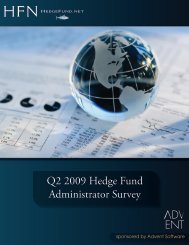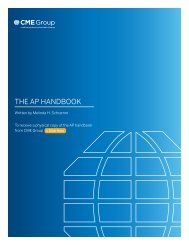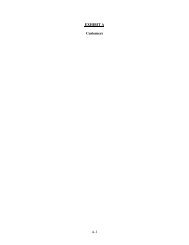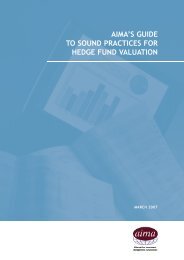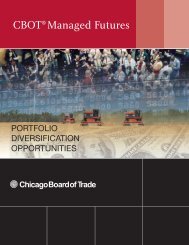AIMA's Illustrative Questionnaire for Due ... - Interconti, Limited
AIMA's Illustrative Questionnaire for Due ... - Interconti, Limited
AIMA's Illustrative Questionnaire for Due ... - Interconti, Limited
You also want an ePaper? Increase the reach of your titles
YUMPU automatically turns print PDFs into web optimized ePapers that Google loves.
AIMA’S QUESTIONNAIRE FOR DUE DILIGENCE OF<br />
MANAGED FUTURES FUND<br />
MANAGERS/COMMODITY TRADING<br />
ADVISORS (CTAs)<br />
Published by<br />
The Alternative Investment Management Association (AIMA)<br />
AIMA’s <strong>Illustrative</strong> <strong>Questionnaire</strong> <strong>for</strong> <strong>Due</strong> Diligence Review of Managed Futures Fund Managers/Commodity Trading Advisors (CTAs)<br />
© Alternative Investment Management Association (AIMA), April 2000
AIMA’s <strong>Illustrative</strong> <strong>Questionnaire</strong> <strong>for</strong> <strong>Due</strong> Diligence Review of<br />
MANAGED FUTURES FUND MANAGERS/COMMODITY TRADING ADVISORS<br />
(CTAS)<br />
The purpose of this document is to serve as a guide to investors in their review and assessment of managed futures fund<br />
managers/CTAs. This due diligence questionnaire is an unavoidable process that investors must follow in order to choose a manager.<br />
It is most important to understand clearly what you plan to invest in. You will also have to:<br />
• identify the markets covered,<br />
• understand what takes place in the portfolio,<br />
• understand the instruments used and how they are used,<br />
• understand how the strategy is operated,<br />
• identify the sources of return,<br />
• understand how ideas are generated,<br />
• check the risk control mechanism,<br />
• know the people you invest with professionally and, sometimes, personally.<br />
Not all of the following questions are applicable to all managers but we recommend that you ask as many questions as possible be<strong>for</strong>e<br />
making a decision.<br />
IMPORTANT<br />
The copyright in this questionnaire belongs to AIMA. You may copy the questionnaire <strong>for</strong> your own company's<br />
use and may distribute it (unamended or amended) <strong>for</strong> the purposes of a due diligence review, but you may not<br />
distribute or copy it <strong>for</strong> any other purpose or to any other person, including any representative of the media,<br />
without the prior written consent of AIMA which will only be given in exceptional circumstances. If you wish to<br />
share the questionnaire with others, please provide their details to AIMA.<br />
DISCLAIMER<br />
Whilst AIMA has used all reasonable ef<strong>for</strong>ts to produce a questionnaire of general application in connection with a due diligence appraisal of<br />
managed futures fund managers/CTAs, in any particular case an investor is likely to have his own individual requirements and each managed futures<br />
fund manager/CTA his own characteristics. As a result, prior to any individual investor sending out the questionnaire, it is strongly recommended that<br />
the questions are reviewed and, where necessary, amended to suit his own requirements and his state of knowledge of the managed futures fund<br />
manager's/CTA’s operations.<br />
In addition, responses to the questionnaire should not be relied upon without review and, where considered appropriate, further investigation. In<br />
order to obtain the best possible in<strong>for</strong>mation on any specific managed futures fund manager additional questions should be raised to clarify any point<br />
of uncertainty, and where practicable verbal examination should be undertaken. In particular, AIMA recommends that in respect of special areas of<br />
concern, such as fund per<strong>for</strong>mance or risk profile, independent third party data should, if possible, be obtained in order to verify these facts.<br />
Accordingly, none of AIMA, its officers, employees or agents make any representation or warranty, express or implied, as to the adequacy,<br />
completeness or correctness of the questionnaire. No liability whatsoever is accepted by AIMA, its officers, employees or agents <strong>for</strong> any loss<br />
howsoever arising from any use of this questionnaire or its contents or otherwise arising in connection therewith.<br />
This questionnaire has been developed <strong>for</strong> Managed Futures Fund Managers/CTAs only and incorporates the input of leading U.S. CTAs and<br />
Commodity Pool Operators (CPOs). It is not intended <strong>for</strong> managers implementing securities-based strategies. A separate questionnaire relating to<br />
hedge fund managers is available from AIMA.<br />
Other AIMA questionnaires available <strong>for</strong> selection of:<br />
Fund of Funds Custody and Administration<br />
Fund of Funds Managers<br />
Fund Administration (excl. Fund of Funds) <strong>for</strong> Investors<br />
Fund Administration (excl. Fund of Funds) <strong>for</strong> Managers<br />
Hedge Fund Managers<br />
Prime Brokers<br />
AIMA’s <strong>Illustrative</strong> <strong>Questionnaire</strong> <strong>for</strong> <strong>Due</strong> Diligence Review of Managed Futures Fund Managers/Commodity Trading Advisors (CTAs)<br />
© Alternative Investment Management Association (AIMA), April 2000
AIMA’s <strong>Illustrative</strong> <strong>Questionnaire</strong> <strong>for</strong> <strong>Due</strong> Diligence Review of<br />
MANAGED FUTURES FUND MANAGERS/COMMODITY TRADING ADVISORS<br />
(CTAs)<br />
CONTENTS<br />
Items<br />
Background<br />
Per<strong>for</strong>mance and Statistics<br />
Methodology<br />
Portfolio and Accounts<br />
Execution and Trading<br />
Risk Management<br />
Research<br />
Administration, Operations and Fees<br />
Legal<br />
Published by<br />
Alternative Investment Management Association (AIMA)<br />
Lower Ground Floor, 10 Stanhope Gate, Mayfair, London W1K 1AL<br />
Tel +44 (0)20 7659 9920 Fax +44 (0)20 7659 9921<br />
www.aima.org<br />
AIMA’s <strong>Illustrative</strong> <strong>Questionnaire</strong> <strong>for</strong> <strong>Due</strong> Diligence Review of Managed Futures Fund Managers/Commodity Trading Advisors (CTAs)<br />
© Alternative Investment Management Association (AIMA), April 2000
NAVIGATING THIS DOCUMENT<br />
INPUTTING DATA<br />
Please use tab-key or point mouse to the beginning of the input field<br />
The size of the fields will automatically adjust to the length of your input<br />
BACKGROUND<br />
ORGANISATION<br />
Company name:<br />
Form of organisation (limited partnership, corporation,<br />
etc.):<br />
Address:<br />
Telephone:<br />
Fax:<br />
E-mail:<br />
Internet/web-site<br />
COMPANY<br />
How many employees does the firm currently have?<br />
What is the greatest and least number of employees the<br />
firm has had in the last 3 years? Explain any significant<br />
employee turnover:<br />
List the names of senior managers in charge of the<br />
following areas:<br />
<br />
<br />
<br />
<br />
<br />
<br />
<br />
Trading:<br />
Research and development:<br />
Marketing and business development:<br />
Administration:<br />
Programming:<br />
Compliance, reporting, per<strong>for</strong>mance:<br />
Other (please specify):<br />
Provide a brief background of the registered principals<br />
and senior managers (education, career background,<br />
etc.). Have any principals or senior managers left the<br />
firm since inception? If yes, please explain:<br />
Provide details of the firm’s current ownership structure<br />
and any changes in the last 3 years. Are there any<br />
pending plans <strong>for</strong> further ownership changes?<br />
What is the firm’s approximate net worth? Is the firm<br />
subject to any minimum net worth requirements or<br />
covenants?<br />
List all branch or affiliated offices, if any:<br />
List the name, location, and function of any nonemployee<br />
representatives being used:<br />
Has the firm ever been registered as any of the<br />
following?<br />
<br />
<br />
<br />
<br />
<br />
<br />
Commodity Pool Operator (CPO):<br />
Commodity Trading Advisor (CTA):<br />
Futures Commission Merchant (FCM):<br />
Introducing Broker (IB):<br />
Registered Investment Advisor (RIA):<br />
Other (please specify):<br />
Has the firm or any of its officers ever been associated<br />
or connected with any:<br />
<br />
<br />
<br />
<br />
Bank:<br />
CPO:<br />
Other CTA:<br />
FCM:<br />
AIMA’s <strong>Illustrative</strong> <strong>Questionnaire</strong> <strong>for</strong> <strong>Due</strong> Diligence Review of Managed Futures Fund Managers/Commodity Trading Advisors (CTAs)<br />
© Alternative Investment Management Association (AIMA), April 2000
Hedge Fund:<br />
IB:<br />
RIA:<br />
Other investment management activity<br />
(please specify):<br />
If yes, please explain:<br />
With which regulatory authority is the firm registered?<br />
Date of registration:<br />
Are all employees registered with the same<br />
authority?<br />
List any professional affiliations and memberships of<br />
the firm and its principals:<br />
List the firm’s accountant/CPA, auditors, and attorneys:<br />
Do any of the firm’s principals have other significant<br />
business involvements? If yes, please describe them<br />
and indicate how much professional time is dedicated<br />
to each?<br />
Has an independent auditor ever reviewed the<br />
per<strong>for</strong>mance record? If yes, please enclose a copy of<br />
the most recent Audit Report.<br />
Has the per<strong>for</strong>mance record been included in any public<br />
fund prospectus in the past five years? Was there a<br />
“com<strong>for</strong>t letter” given in respect of the record?<br />
Are there any issues from the firm’s most recent<br />
regulatory review (NFA, SEC, CFTC, etc.) currently<br />
unresolved? If yes, please provide a detailed<br />
explanation:<br />
Does the firm have a current CFTC Reg. 4.21 Disclosure<br />
Document or a Reg. 4.7 Disclosure Document? If yes,<br />
please provide a copy:<br />
How soon is the next update due to the firm’s<br />
Disclosure Document? Are any material disclosure<br />
changes anticipated?<br />
Does the firm publish any newsletters or other<br />
publications? If yes, please provide copies.<br />
Provide two samples of reports typically sent to clients:<br />
If not confidential, please provide a partial list of<br />
existing clients with an indication of how long they have<br />
been clients. Please also show the amount of assets<br />
managed <strong>for</strong> them currently, as well as at the beginning<br />
of the last four fiscal years:<br />
Provide three client references:<br />
What is the greatest percentage of assets under<br />
management represented by any single client?<br />
Does the firm manage an account <strong>for</strong> any government<br />
pension plans or entities?<br />
Which investor groups does the firm primarily target?<br />
Does the firm permit “feeder funds” into its own<br />
investment products?<br />
Has the firm made any future capacity commitments in<br />
terms of the right to place additional assets under the<br />
firm’s management?<br />
PERFORMANCE & STATISTICS<br />
Attach 13-column composite per<strong>for</strong>mance tables <strong>for</strong> all<br />
accounts traded pursuant to each of the firm’s<br />
programmes (if available – see below):<br />
AIMA’s <strong>Illustrative</strong> <strong>Questionnaire</strong> <strong>for</strong> <strong>Due</strong> Diligence Review of Managed Futures Fund Managers/Commodity Trading Advisors (CTAs)<br />
© Alternative Investment Management Association (AIMA), April 2000
List assets under management (and percentage of total<br />
assets) <strong>for</strong> each of the following:<br />
<br />
<br />
<br />
<br />
<br />
<br />
Public funds:<br />
Private pools:<br />
Individual accounts:<br />
Institutional accounts:<br />
Proprietary accounts:<br />
Total assets under management:<br />
If 13-column tables are not attached, attach a schedule showing month-end assets under management <strong>for</strong> each programme since inception.<br />
Note: indicate any notional funding and any non-standard leverage applied, if any.<br />
Is the per<strong>for</strong>mance record actual or hypothetical?<br />
Is the per<strong>for</strong>mance record in any respect derived or<br />
excerpted?<br />
Is proprietary (and, presumably, non-fee-paying) capital<br />
included in the per<strong>for</strong>mance record? If yes, what<br />
amount?<br />
Are there any material differences among the accounts<br />
included in the composite tables?<br />
Are “exempt accounts” included or excluded from the<br />
per<strong>for</strong>mance record?<br />
Does the per<strong>for</strong>mance record reflect the full brokerage<br />
charged to the client or have certain fund sponsors<br />
identified a portion of such brokerage as excludable<br />
from the firm’s per<strong>for</strong>mance calculations?<br />
List all markets now traded which are not included in<br />
the past five years’ per<strong>for</strong>mance:<br />
What was the peak of assets under management?<br />
<br />
<br />
US$:<br />
Date:<br />
Has the firm ever voluntarily returned assets to<br />
investors? If so, when, how much and why?<br />
How many separately managed accounts are currently<br />
open, grouped by size?<br />
$0 to $250,000:<br />
$250,001 to $1,000,000:<br />
$1,000,001 to $5,000,000:<br />
$5,000,001 to $10,000,000:<br />
$10,000,001 to $20,000,000:<br />
$20,000,001 +:<br />
<br />
Total:<br />
What percentage of the assets under management<br />
consists of “notional equity”?<br />
What is the current equity value and starting date of the<br />
oldest continuously traded account?<br />
Does the per<strong>for</strong>mance record include interest income?<br />
If yes, explain basis of inclusion.<br />
Have any agreements or understandings been reached<br />
with the CFTC/NFA regarding any aspects of the<br />
per<strong>for</strong>mance record?<br />
Are ther any pro <strong>for</strong>ma adjustments included in the<br />
per<strong>for</strong>mance record? If so, how are these calculated?<br />
What is the average number of round-turns traded per<br />
$1million per year in each programme?<br />
Approximately how many trades are made in each<br />
market, each year, in each programme?<br />
Does trading frequency tend to increase/decrease<br />
during profitable/unprofitable periods?<br />
What is the average annual commission as a percentage<br />
AIMA’s <strong>Illustrative</strong> <strong>Questionnaire</strong> <strong>for</strong> <strong>Due</strong> Diligence Review of Managed Futures Fund Managers/Commodity Trading Advisors (CTAs)<br />
© Alternative Investment Management Association (AIMA), April 2000
of assets included in the per<strong>for</strong>mance record <strong>for</strong> each<br />
programme? Does this vary significantly from year to<br />
year?<br />
What is the average management and per<strong>for</strong>mance fee<br />
structure included in the per<strong>for</strong>mance record?<br />
Do fees and/or commissions vary significantly from<br />
year to year? If so, by how much?<br />
What is the average percentage of winning and losing<br />
trades in each programme since inception? Are these<br />
percentages materially different to the past 12 months?<br />
If yes, please explain:<br />
What is the average gain per winning trade and average<br />
loss per losing trade?<br />
<br />
<br />
$ per contract:<br />
As a % of equity:<br />
What is the average holding period <strong>for</strong>:<br />
<br />
<br />
<br />
All trades:<br />
Winning trades:<br />
Losing trades:<br />
What is the maximum amount of equity that the firm<br />
estimates can be traded in each programme?<br />
What is the annualised standard deviation, Sharpe Ratio<br />
and compound annual rate of return <strong>for</strong> each<br />
programme? How do these compare with the firm’s<br />
objectives?<br />
List the three largest drawdowns as percentages of<br />
equity <strong>for</strong> each programme. Please also explain why<br />
each drawdown occurred, and show the recovery<br />
periods:<br />
What were the three longest drawdowns <strong>for</strong> each<br />
programme? Please explain:<br />
What were the largest withdrawals in each programme<br />
since inception?<br />
<br />
<br />
<br />
Date:<br />
% of equity:<br />
Reasons:<br />
Has the firm ever permitted a client to intervene during<br />
the course of a relationship to adjust leverage or<br />
portfolio structure? If yes, please explain:<br />
What do you believe is the most important per<strong>for</strong>mance<br />
measurement with respect to each programme?<br />
What is the projected growth in assets under<br />
management over the next twelve months?<br />
Have there been any material leverage or other<br />
adjustments in the past five years, and how have such<br />
adjustments affected the per<strong>for</strong>mance record?<br />
METHODOLOGY<br />
How would you characterise the firm’s basic trading<br />
approach (in %)?<br />
<br />
<br />
<br />
Discretionary:<br />
Systematic:<br />
Other, please explain:<br />
How would you characterise the firm’s main decisionmaking<br />
inputs (in %)?<br />
<br />
<br />
<br />
Fundamental:<br />
Technical:<br />
Other, please explain:<br />
AIMA’s <strong>Illustrative</strong> <strong>Questionnaire</strong> <strong>for</strong> <strong>Due</strong> Diligence Review of Managed Futures Fund Managers/Commodity Trading Advisors (CTAs)<br />
© Alternative Investment Management Association (AIMA), April 2000
Do you believe that one trader can have materially<br />
better systems than another? Please explain:<br />
What other advisors would you compare your firm to as<br />
most similar? In what respects?<br />
Which components of the firm’s system, if any, do you<br />
regard as proprietary (no details necessary)?<br />
Why are major financial institutions, with their extensive<br />
resources, not implementing the same programmes as<br />
the firm in their proprietary trading?<br />
Are there any “relative value” or “arbitrage” aspects to<br />
the programme?<br />
Are calendar spreads or inter-market spreads used?<br />
How would you characterise the firm’s trading<br />
methodology (in %)?<br />
<br />
<br />
<br />
<br />
<br />
<br />
<br />
Trend Following<br />
1.Regression analysis:<br />
2.Moving Average:<br />
3.Breakout systems:<br />
4.Pattern recognition:<br />
5.Oscillators;<br />
6.Other (please explain):<br />
Cyclical:<br />
Countertrend:<br />
Special Situtation:<br />
Arbitrage:<br />
Market Neutral:<br />
Other (please explain):<br />
How, if at all, is “game theory” incorporated into the<br />
firm’s trading strategies?<br />
If the firm operates different programmes, are they<br />
managed by “independent account control” or are<br />
positions aggregated <strong>for</strong> Speculative Position Limit<br />
purposes?<br />
Do all the programmes use the same trading<br />
methodology? If not, please explain.<br />
Describe the firm’s broad trading philosophy, strategy<br />
and core principles in as much detail as possible.<br />
Describe the development of the firm’s trading<br />
methodology. Please include all material modifications<br />
made to the methodology over the period of the<br />
per<strong>for</strong>mance record:<br />
What do you believe gives the firm a competitive<br />
advantage or an “edge”?<br />
What are the strengths and weaknesses of the firm’s<br />
trading methodology?<br />
What makes the firm’s trading methodology different<br />
from other CTAs?<br />
How do you determine the programmes’ commitment to<br />
different market sectors?<br />
How frequently do you alter the programmes’<br />
commitment to different market sectors?<br />
Do you alter the programme during drawdowns? As a<br />
result of drawdowns?<br />
During drawdowns, does the firm tend to increase or<br />
decrease the scop of its discretionary decision-making<br />
and non-systematic responses?<br />
Did one or more of the current principals develop the<br />
firm’s trading methodology? If not, who did?<br />
AIMA’s <strong>Illustrative</strong> <strong>Questionnaire</strong> <strong>for</strong> <strong>Due</strong> Diligence Review of Managed Futures Fund Managers/Commodity Trading Advisors (CTAs)<br />
© Alternative Investment Management Association (AIMA), April 2000
Could the unavailability of any of the firm’s principals<br />
influence the trading methodology?<br />
Does the firm own the trading methodology currently<br />
being used? If not, who does?<br />
Are there any patents, trademarks, etc. held by the firm<br />
or any of its principals?<br />
Describe the three worst trading experiences the firm<br />
has had, and explain how they influenced the evolution<br />
of the firm’s trading methodology.<br />
If the firm’s trading methodology is computerised and<br />
systematic:<br />
<br />
<br />
<br />
<br />
<br />
<br />
<br />
<br />
<br />
<br />
Is the trading system ever overridden? If<br />
yes, under what circumstances?<br />
Does the trading system ever add to or<br />
reduce profitable or losing positions? If yes,<br />
under what circumstances? Are there<br />
maximum additions? If so, how is the<br />
maximum determined?<br />
Are multiple trading systems used? If yes,<br />
please explain:<br />
Does the firm apply the same system to all<br />
markets or are there different systems <strong>for</strong><br />
each?<br />
What technical or fundamental in<strong>for</strong>mation<br />
is considered important <strong>for</strong> a trade entry<br />
signal?<br />
Are entry and exit signals generated by the<br />
same trading system? If not, please explain<br />
how they are generated differently.<br />
Does the trading methodology differ frm<br />
market to market? If yes, please describe<br />
what the difference is based on?<br />
Is the trading system always with long or<br />
short, or is there also a neutral zone?<br />
Please explain:<br />
How frequently are changes made to the<br />
trading system? Please explain the<br />
development and implementation process:<br />
Is the firm’s research focused on developing<br />
new trading systems or on further refining<br />
the existing systems?<br />
Is the “cost of carry” a factor in the current<br />
methodology?<br />
Which of the following activities are influenced by<br />
subjective judgement? Please answer by Yes or No,<br />
and indicate a % where applicable:<br />
<br />
<br />
<br />
<br />
<br />
<br />
<br />
<br />
<br />
<br />
Portfolio structure:<br />
Trade entry:<br />
Trade exit:<br />
Stops:<br />
Position size:<br />
Overall leverage:<br />
Selection of contract maturity:<br />
Addition to or reduction of winning or losing<br />
positions:<br />
Decision to halt trading:<br />
Other (please specify):<br />
If fundamental in<strong>for</strong>mation is used, what are its<br />
AIMA’s <strong>Illustrative</strong> <strong>Questionnaire</strong> <strong>for</strong> <strong>Due</strong> Diligence Review of Managed Futures Fund Managers/Commodity Trading Advisors (CTAs)<br />
© Alternative Investment Management Association (AIMA), April 2000
sources?<br />
How would the firm approach sudden and unexpected<br />
illiquidity in any of the markets traded?<br />
Do you permit fundamental factors to influence risk<br />
management (e.g. liquidating or reducing certain<br />
positions be<strong>for</strong>e a G-7 meeting)?<br />
Are any filters used when selecting trades? If yes,<br />
please explain:<br />
Has the firm made any leverage adjustments in the<br />
past? If yes, why? When and how were they<br />
implemented?<br />
Has the firm made any specific modifications intended<br />
to reduce volatility? If yes, why? When and how were<br />
they implemented?<br />
Will the firm modify a trading methodology or portfolio<br />
at particular clients’ request? If yes, please explain:<br />
Of the techniques below, which are used in the firm’s<br />
trading methodology?<br />
<br />
<br />
<br />
<br />
<br />
<br />
<br />
<br />
<br />
<br />
<br />
<br />
<br />
<br />
<br />
Moving averages of prices:<br />
Chart patterns (head & shoulders, triangles,<br />
flags, etc.):<br />
Momentum oscillators (rate of change of<br />
price or volume):<br />
Point and figure;<br />
Support and resistance:<br />
Volume or open interest:<br />
Spread relationships:<br />
Statistical probabilities:<br />
Penetration identification:<br />
Overbought/oversold indicators:<br />
Cyclical analysis:<br />
Seasonal analysis:<br />
Fundamental or economic analysis:<br />
Bottom up analysis:<br />
Top down analysis:<br />
If the trading methodology involves a neural network,<br />
what are its main inputs?<br />
Are any of the methods below used to close out<br />
profitable positions? Please indicate by Yes or No, and<br />
%:<br />
<br />
<br />
<br />
<br />
<br />
<br />
<br />
<br />
<br />
Trend reversal:<br />
Trailing stops:<br />
Overbought/oversold indicators:<br />
Volatility:<br />
Price patterns:<br />
Volume/open interest:<br />
Spread relationships:<br />
Change in fundamentals:<br />
Other (please explain):<br />
Does the trading system have a long or short bias?<br />
Has the trading method been adjusted, or have the<br />
markets traded changed due to increased assets under<br />
management? If yes, please explain:<br />
Do you believe that the firm’s per<strong>for</strong>mance is likely to be<br />
non-correlated with other trading advisors? If yes,<br />
please explain:<br />
What are the firm’s rate or return, volatility, and Sharpe<br />
Ratio objectives?<br />
AIMA’s <strong>Illustrative</strong> <strong>Questionnaire</strong> <strong>for</strong> <strong>Due</strong> Diligence Review of Managed Futures Fund Managers/Commodity Trading Advisors (CTAs)<br />
© Alternative Investment Management Association (AIMA), April 2000
What is the firm’s S&P non-correlation objective?<br />
Does the trading methodology work better in some<br />
markets than in others? If yes, please explain:<br />
Are certain markets excluded from the portfolios? If<br />
yes, please explain:<br />
Are there liquidity, regulatory or other requirements <strong>for</strong><br />
the inclusion of markets in the firm’s portfolios? If yes,<br />
please explain:<br />
In which kind of markets does the trading methodology<br />
per<strong>for</strong>m best and worst?<br />
<br />
<br />
<br />
<br />
<br />
<br />
<br />
<br />
Bull markets<br />
Bear markets<br />
Congested markets<br />
Bull and bear markets, but not congested<br />
markets:<br />
The same in all market conditions:<br />
High volatility markets:<br />
Low volatility markets:<br />
Other (please explain):<br />
Are agricultural commodities a significant component in<br />
any of the firm’s portfolios?<br />
Does the firm’s methodology permit or require making<br />
or taking develiery of physical commodities?<br />
Does the firm trade “cash” securities (stocks and<br />
bonds)? Why would or would not the firm’s programme<br />
be effective in doing so?<br />
What was the firm’s response to the introduction of the<br />
Euro?<br />
Will increasingly competitive markets affect the<br />
per<strong>for</strong>mance of firm’s programmes? Will they affect<br />
managed futures in general?<br />
Do you perceive any basic and significant changes in<br />
the managed futures industry over the past five years?<br />
Does the firm offer “overlay” as well as “standard”<br />
programmes? If so, please explain the difference:<br />
Does the firm use third-party research or valuation<br />
service providers?<br />
PORTFOLIO & ACCOUNTS<br />
Which of the following instruments are traded and in<br />
what percentages?<br />
<br />
<br />
<br />
<br />
<br />
<br />
<br />
<br />
Exchange-traded futures:<br />
Exchange-traded options:<br />
EFPs:<br />
OTC <strong>for</strong>wards:<br />
OTC options:<br />
Swaps:<br />
Cash debt instruments:<br />
Cash equities:<br />
Attach a complete list of all markets traded in each of<br />
the above categories. With respect to all OTC, swap,<br />
and cash markets, please list the counterparts used in<br />
each market:<br />
If options are traded, please explain which types:<br />
<br />
<br />
<br />
Covered only, naked, as part of a hedging<br />
strategy, “exotic”, etc.:<br />
How they are used:<br />
How they are revalued:<br />
AIMA’s <strong>Illustrative</strong> <strong>Questionnaire</strong> <strong>for</strong> <strong>Due</strong> Diligence Review of Managed Futures Fund Managers/Commodity Trading Advisors (CTAs)<br />
© Alternative Investment Management Association (AIMA), April 2000
If options are traded, what option-related volatility<br />
measures are incorporated into the programme?<br />
Do the markets traded vary according to the account<br />
size? If yes, please explain:<br />
How are the markets included in each portfolio<br />
selected?<br />
Can a portfolio be customised according to specific<br />
customer requirements?<br />
Do customised accounts appear in the firm’s composite<br />
per<strong>for</strong>mance record?<br />
What is the minimum account size? What is the<br />
minimum optimal account size?<br />
For each programme, what would a $1 million portfolio<br />
look like? For example,<br />
<br />
<br />
Which markets would be included?<br />
How many contracts of each market would<br />
be included?<br />
Which criteria are considered in portfolio selection (risk,<br />
per<strong>for</strong>mance, liquidity, volume, open interest, etc.)?<br />
Position limits:<br />
<br />
<br />
<br />
Describe any past problems with Position<br />
Limits. Which markets or exchanges were<br />
involved?<br />
How much money could be managed under<br />
the current trading methodology without<br />
being restricted by Position Limits?<br />
If, or when, Position Limits are reached, how<br />
will the firm modify its methodology?<br />
Do you believe that most trading advisors’ rates of<br />
return decrease as assets under management increase?<br />
Why? What about your firm’s programmes?<br />
EXECUTION & TRADING<br />
How are positions established <strong>for</strong> new accounts,<br />
liquidated <strong>for</strong> terminating accounts, or adjusted <strong>for</strong><br />
existing accounts to reflect material changes in account<br />
equity? Please explain in detail:<br />
Does the firm’s trading staff trade 24 hours per day? If<br />
yes, please explain. Do they trade from the office<br />
premises or elsewhere? How many staff are involved in<br />
each shift, and what are their functions?<br />
How are executed trades allocated to accounts? Please<br />
explain in detail, partiulclarly with respect to split fills.<br />
Are any positions allocated as of the end of the trading<br />
day rather than prior to or at the time of order entry?<br />
What is the firm’s policy with respect to trading and<br />
system errors? Please explain in detail.<br />
Have there been any major “out-trades”? If so, please<br />
describe.<br />
Trading Orders:<br />
<br />
<br />
<br />
<br />
<br />
What types of trading orders are used?<br />
Are different types of orders used <strong>for</strong> entry<br />
and exit? Please explain:<br />
Are orders entered onto a trading desk or<br />
relayed directly to the exchange floor?<br />
Are large orders broken up? If yes, please<br />
explain how:<br />
Does the firm use give-ups <strong>for</strong> futures? If<br />
AIMA’s <strong>Illustrative</strong> <strong>Questionnaire</strong> <strong>for</strong> <strong>Due</strong> Diligence Review of Managed Futures Fund Managers/Commodity Trading Advisors (CTAs)<br />
© Alternative Investment Management Association (AIMA), April 2000
yes, please provide a complete list of<br />
executing brokers used and give-up fees<br />
charged by those brokers. If no, please<br />
provide a complete list of executing brokers<br />
used:<br />
If the firm uses a Prime Broker <strong>for</strong> FX, please<br />
describe the structure and any fees charged:<br />
What is the firm’s policy with respect to trading by:<br />
Staff:<br />
Principals:<br />
The firm itself:<br />
Does the firm have any special relationship or affiliation<br />
with any FCM?<br />
If the firm trades EFPs, describe the manner in which<br />
appropriate documentation is maintained:<br />
If the firm trades EFPs, please list all markets in which<br />
they are traded. Please also list the counterparts with<br />
whom they are traded:<br />
RISK MANAGEMENT<br />
Describe the firm’s overall risk management principles<br />
and approach:<br />
How does the firm calculate risk?<br />
Is the risk calculated <strong>for</strong> each trade? If yes, please<br />
explain:<br />
Do all the programmes use the same risk management<br />
methodology? If not, please explain:<br />
Is “value at risk” used in the firm’s programme? If so,<br />
how do you assess the value at risk of your different<br />
market positions and what confidence level do you use?<br />
What determines the amount of leverage used?<br />
How much leverage (% of margin to equity) is used in<br />
each programme?<br />
Highest:<br />
Lowest:<br />
Average:<br />
What is the percentage of risk invested in any single<br />
market?<br />
Highest:<br />
Lowest:<br />
Average:<br />
How is this percentage determined?<br />
Are “higher leverage” and “lower leverage” versions of<br />
the same programme offered? If yes, please explain<br />
how they are structured?<br />
Does the firm impose limits on the amount of margin<br />
committed to different markets, sectors, or portfolios?<br />
How does the firm react if the volume and/or open<br />
interest of a market in which a position is held are<br />
suddenly reduced significantly?<br />
Does adding or reducing a position in one market ever<br />
influence the size of positions held in other markets? If<br />
yes, please explain:<br />
Does the firm calculate and anlyse the historical or<br />
contemporary correlation between markets? If yes, how<br />
does such analysis influence portfolio design?<br />
AIMA’s <strong>Illustrative</strong> <strong>Questionnaire</strong> <strong>for</strong> <strong>Due</strong> Diligence Review of Managed Futures Fund Managers/Commodity Trading Advisors (CTAs)<br />
© Alternative Investment Management Association (AIMA), April 2000
Does the firm establish position limits <strong>for</strong> correlated<br />
market groups? If yes, please explain:<br />
Are there a minimum number of markets in which the<br />
firm always holds positions in order to achieve a<br />
minimal portfolio diversification effect?<br />
If stops are used, please answer the following<br />
questions:<br />
On what principles are stops calculated?<br />
How often are stops adjusted?<br />
Is the method of establishing stops based<br />
on any of the following?<br />
1. Price stops:<br />
2. Time stops:<br />
3. Volatility stops:<br />
4. Money management stops:<br />
5. Other (please specify):<br />
If a stop is reached, is the entire position<br />
closed out at one time, or is the position<br />
reduced gradually?<br />
How are positions adjusted when there is a significant<br />
increase or decrease in equity due to trading profits or<br />
losses?<br />
Are there any circumstances under which all positions<br />
in the portfolio will be closed?<br />
At what percent drawdown would the firm either stop<br />
trading or recommend that an account be closed?<br />
Does the methodology react to volatility changes in the<br />
markets? If yes, please explain how.<br />
Does the firm trade on exchanges that are open outside<br />
local office hours? If yes:<br />
How is the time difference managed?<br />
Are there routines in place to minimise the<br />
risk of adverse price movements, or price<br />
gaps which are due to price movements that<br />
occur outside local office hours?<br />
What is the estimated maximum risk on a total<br />
portfolio? Please describe the method by which such<br />
risk is measured:<br />
What is the firm’s cash management method? Does<br />
this create an additional source of risk?<br />
RESEARCH<br />
Describe the firm’s ef<strong>for</strong>ts to improve its trading<br />
methodology through on-going research?<br />
What is the firm’s current annual research budget?<br />
How much money has the firm invested in research<br />
since its inception?<br />
Has the firm or any of its research staff published any<br />
research or academic papers? If yes, please provide<br />
details:<br />
Does the firm use any external parties or resources <strong>for</strong><br />
research? If yes, please explain.<br />
ADMINISTRATION, OPERATIONS AND FEES<br />
Describe detailed backup procedures in the event that<br />
the firm’s offices, trading facilities or computer system<br />
became unexpectedly non-operational or inaccessible.<br />
Does the firm maintain a detailed Operations Manual?<br />
AIMA’s <strong>Illustrative</strong> <strong>Questionnaire</strong> <strong>for</strong> <strong>Due</strong> Diligence Review of Managed Futures Fund Managers/Commodity Trading Advisors (CTAs)<br />
© Alternative Investment Management Association (AIMA), April 2000
What insurance coverage does the firm maintain?<br />
Please provide a schedule showing coverage:<br />
Are the operations of the firm dependent on one person<br />
or a limited number of people?<br />
Is there a minimum number of personnel needed <strong>for</strong> the<br />
firm’s operations?<br />
Have there been any significant operational or<br />
administrative “bottlenecks” or difficulties in the past<br />
five years?<br />
Are new investments currently being accepted in the<br />
<strong>for</strong>m of:<br />
<br />
<br />
<br />
Separately managed accounts:<br />
Pools and funds:<br />
Both of the above:<br />
Is the client free to choose a clearing firm and to<br />
negotiate the account terms directly with them?<br />
Which clearing firms does the firm currently use?<br />
What fees do the firm charge? Do they vary? If so,<br />
please explain:<br />
<br />
<br />
<br />
Management fee (include frequency of<br />
payment):<br />
Per<strong>for</strong>mance fee (include frequency of<br />
payment):<br />
If a “hurdle rate” is included in the<br />
Per<strong>for</strong>mance fee calculation, is it a “hard” or<br />
a “soft” hurdle?<br />
Does the firm charge all customers the same fees? If<br />
not, on what basis are fees waived or modified?<br />
Does the firm share its fees with any third parties?<br />
Are there any present plans to relocate the firm’s offices<br />
Does the firm have a lockup period or any special<br />
requirements <strong>for</strong> withdrawal?<br />
Does the firm or any of its officers or employees<br />
receive, directly or indirectly, any rebate on brokerage<br />
commissions? If yes, please explain on what basis, and<br />
from which brokerage firms:<br />
Has the firm ever been required to restate NAVs, fees or<br />
other calculations? If yes, please explain:<br />
LEGAL<br />
Does the firm hire traders from other investment<br />
management firms?<br />
Has the firm had any disputes over non-compete, nondisclosure<br />
or similar covenants?<br />
Are any of the firm’s employees subject to noncompetes,<br />
“golden handcuffs”, etc.?<br />
Does the firm have any existing marketing or consulting<br />
agreements?<br />
Has the firm appeared in any recent advertisement or<br />
newspaper or magazine articles?<br />
Have there ever been any criminal, civil or<br />
administrative proceedings against the firm or any of its<br />
principals, or any similar such matters including<br />
reparations, arbitrations and negotiated settlements?<br />
Does the firm maintain a written Compliance Manual? If<br />
yes, please provide a copy.<br />
Does the firm or any affiliate ever take “custody” of<br />
client assets?<br />
AIMA’s <strong>Illustrative</strong> <strong>Questionnaire</strong> <strong>for</strong> <strong>Due</strong> Diligence Review of Managed Futures Fund Managers/Commodity Trading Advisors (CTAs)<br />
© Alternative Investment Management Association (AIMA), April 2000
Does the firm or any affiliate ever deduct its fees<br />
directly from any client accounts?<br />
What is the firm’s liability/indemnity standard?<br />
Does the firm make use of “soft dollars”?<br />
Please attach copies of the following documents and <strong>for</strong>ms where applicable:<br />
Management/Advisory Agreement<br />
Corporate brochure, and other marketing literature<br />
Disclosure Document<br />
Newsletters or other publications<br />
Client Reports<br />
Client References<br />
13-Column Per<strong>for</strong>mance Tables<br />
Compliance Manual<br />
Please state the name and title of the officer at your firm who has prepared and reviewed this questionnaire.<br />
Signature:<br />
Name:<br />
Date:<br />
Position:<br />
AIMA’s <strong>Illustrative</strong> <strong>Questionnaire</strong> <strong>for</strong> <strong>Due</strong> Diligence Review of Managed Futures Fund Managers/Commodity Trading Advisors (CTAs)<br />
© Alternative Investment Management Association (AIMA), April 2000



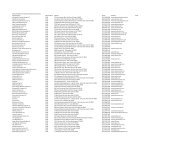
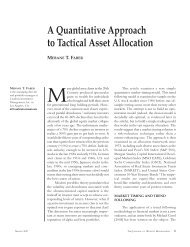
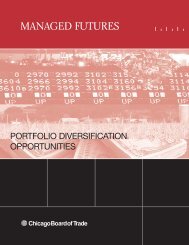
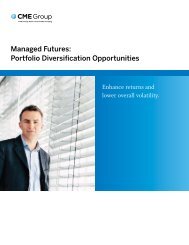
![Definitions & Concepts... [PDF] - Cycles Research Institute](https://img.yumpu.com/26387731/1/190x245/definitions-concepts-pdf-cycles-research-institute.jpg?quality=85)
